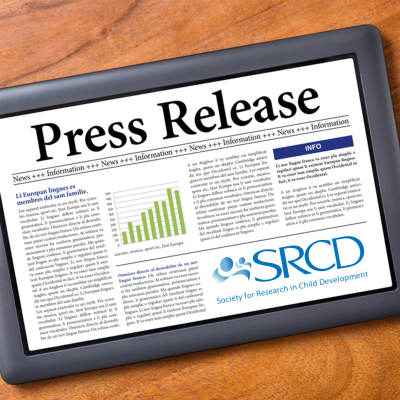“What a wonderful day, I’m so happy!” Research Shows How Children Learn Emotion Labels Through Parents’ Speech
PRESS RELEASE / CHILD DEVELOPMENT: Embargoed for Release on February 28, 2023
Learning about emotions is an important part of children’s social and communicative development. Whether children can use words like “happy” or “sad” to talk about emotions predicts how well they get along with their peers, self-soothe after a negative event, and thrive at school. A study released in Child Development by researchers at Princeton University in New Jersey, United States examined language production and input among English-speaking toddlers to assess whether emotion labels (such as “happy,” which directly name an internal emotional state) might help children learn their meaning. The team explored the emergence of valenced (i.e., positive and negative) words in children’s productive vocabulary and how parents and caregivers may support young children’s learning of emotion labels. The research suggests that young children use the dynamics of language input to construct emotion word meanings and provides new techniques for defining the quality of infant-directed speech.
“Our research shows that children are more likely to know a given emotion label when they also know many other related valenced words,” said Mira Nencheva, a graduate student in psychology at Princeton University “If parents surround emotion labels with related words, they may support children’s learning. For example, when introducing the label happy, a parent or caregiver can provide information about the situation or actions that surround the emotion (such as Rosa got a wonderful present for her birthday! She was so happy!).”
Researchers used data collected in North America and the United Kingdom between 1962 and 2009, from the MacArthur-Bates Communicative Development Inventory Wordbank database. Across five studies, they analyzed vocabularies of 5,520 toddlers (1,989 female and 2, 2015 male) between the ages of 16 and 30 months. sixteen- and thirty-months. 2,202 identified as White, 67 as Asian, 222 as Black, 131 as Hispanic, and 93 as Other. The Wordbank database asked caregivers to report which 680 words their child understands and speaks. The words included in the database were selected to represent children’s first words.
The data were examined using the following steps:
- In Studies 1 and 2, researchers examined the development of 1- to 2-year-olds' valenced words and looked at the rate in which they learned emotional and neutral words.
- The research helped reveal that learning starts with concrete neutral words (i.e., spoon or shake) and then expanded to positive and negative words.
This is consistent with previous research which showed that older children learn negative and positive words earlier than neutral, abstract words.
- Study 3 examined how caregivers use emotion labels within context that match in valence.
- Study 4 investigated whether variability in the extent to which different emotion labels lend themselves to such co-occurrence in child-directed speech predicts earlier or later production.
- Study 5 examined the longitudinal hypothesis that children produce emotion labels in more accurate contexts when their caregivers surround emotion labels with similar words.
Studies 3, 4 and 5 show that caregiver input may include consistent links between emotion labels and similarly valenced words, which may facilitate children’s learning over time. In all, the research shows that it may be important for caregivers to provide related words when labeling emotions to help children make sense of complex words. The findings also have implications for understanding children’s word learning beyond emotion labels and related valenced words.
“Our five studies provide insight into how young children may use dynamic language input to construct complex meanings,” said Nencheva. “It is our intent that our approach will help enable other researchers to quantify how caregivers dynamically use words that support children’s learning of words with complex, abstract meanings.”
The authors acknowledge several limitations in their research. For some of the analyses, they were limited by the words included in the MacArthur-Bates Communicative Development Inventory Wordbank database which included very few emotion labels. The questionnaire was also specifically designed for infants and toddlers so future research across a wider age range from infancy to childhood to adolescence is recommended. Future research should directly study the causal links between caregiver input in using emotional labels and similary-valenced words and children’s learning over time. Finally, the parent-report measures of their child’s productive vocabulary are not as robust as children-driven measures of production and comprehension.
###
This work was supported by the National Institutes of Health and the Association for Computing Machinery Special Interest Group on High Performance Computing of the Association for Computing Machinery Computational & Data Science Fellowship.
Summarized from Child Development, Caregiver speech predicts the emergence of children’s emotion vocabulary by Nencheva, M., Tamir, D., and Lew-Williams, C. (Princeton University). Copyright 2023 The Society for Research in Child Development, Inc. All rights reserved.


